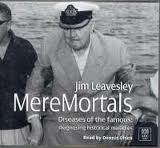Friday, 4 November 2011
Mere Mortals
My latest in car listening has been to the totally wonderful Mere Mortals. A series of retrospective medical musings on famous people in history, written by a now retired GP Dr Jim Leavesley. Sadly this is only a selection of the 45 people included in the book format- and I will now have to read the book in it's entirety! These essays were written as programs for the wonderful Ockham's Razor on Radio National from the 1980s. Ockham's Razor is still broadcast on Sunday mornings.
Claudius
Joan of Arc
Henry VIII
Queen Anne
Samuel Pepys
Winston Churchill
Elizabeth Barrett Browning
The Brontes
Queen Victoria
Vincent Van Gogh
John F Kennedy
Some of these people had quite well known maladies of course. Churchill's black dog of depression. TB consumed the Bronte family. Samuel Pepys was famously cut for stone (bladder stones). And Queen Victoria spread her tendency for haemophilia through many of the royal houses of Europe.
My favourite section was the particularly fascinating one on Joan of Arc. She is of course famous enough that we all know her name, and know that she was burnt at the stake. But why was a 19 year old girl burnt at the stake? Why indeed was she involved in leading battles against the English? It does seem odd that an illiterate teenage girl should be leading French armies. I really hadn't thought about her much before now. Even though I've often walked past her statue on the Rue de Rivoli, and gazed at her golden wonder.
Joan was the youngest of five children born in the village of Domremy in what is now Lorraine. She began having a series of well documented auditory, olfactory and visual hallucinations when a teenager. Some have suggested that this may have been schizophrenia, but here Jim Leavesley suggests temporal lobe epilepsy. She had frequent, prolonged hallucinations from the time she was 13 but never developed a formal thought disorder.
Somehow Joan convinced the dauphin to trust her, and he put her in charge of the army. She liberated Orleans, insisted the dauphin then become crowned King of France at Reims, and went on to fight aggressively and courageously against the English, who at that time had control of most of Northern France including Paris.
Joan endured several gynaecological examinations to prove her piety, which allow her to become known as the Maid of Orleans. She is reported to have fully developed breasts, but no pubic hair, and never reached menarche. The author reports the theory that she has the rare condition of testicular feminization. Leavesly asserts that was burned at the stake for wearing mens clothing, rather than for her hallucinations, or any suggestion that she was a witch. As a final indignity her charred body was revealed to the crowd assembled to watch her death, as there was sufficient doubt about her sex, despite her feminine voice, that she was said to have loved finery, and been easily moved to tears. Her entrails reportedly didn't burn at the stake, which is quite unusual of course and Leavesley suggests that they may have been hardened by deposits of calcium due to TB, they had to be thrown into the Seine.
I'm really fascinated by Joan, and I will definitely be reading more about her.
The final section on John F Kennedy was also particularly fascinating. I wasn't aware that JFK had two particular problems with his health. He had Addison's Disease, a condition where the adrenal glands don't make the usual amount of steroid hormones that are required, and needs supplementation. He also had a back injury, that had required several surgeries, and JFK was apparently one of the first people with Addison's to survive surgery. JFK would often use crutches when out of the public eye, and wore an intricate sounding rigid brace which he was wearing at the time of his death in Dallas in 1963. Indeed, Leavesley suggests that the rigid back brace may have caused the shooting to be fatal. He believes that the rigid brace held JFK upright whereas if he had been able to slump after the first shot he may not have been fatally wounded by the third. It certainly sounds plausible. And makes it all the more tragic I think.
And what of the audiobook experience? I really enjoyed the reader here. Plummy, full voiced. He reminded me of the narrator in Rocky Horror in places. Although he does mispronounce some medical terms at times, which is a little bit distracting, but otherwise it's a completely engaging pleasure to listen to.
Subscribe to:
Post Comments (Atom)


2 comments:
I believe that the latest theory put forward in the new Vincent van Gogh biography is that he also had temporal lobe epilepsy.
This looks like a fascinating book that I will put on my list. Thanks.
That's very interesting about Vincent Dvora. I hadn't heard that about the new book. There was the blaze of publicity about it, as they have speculated he was shot by kids instead of shooting himself. That sounded plausible, but then these things always do.
Leavesley suggests that his fondness for yellow in his later years was a result of digitalis (foxglove) toxicity. Apparently Vincent was treated for epilepsy during his life time, and foxglove was one of the treatments used at that time.
Another fascinating snippet about him is that in the two days between his shooting and his death he managed to do his final two paintings.
Post a Comment